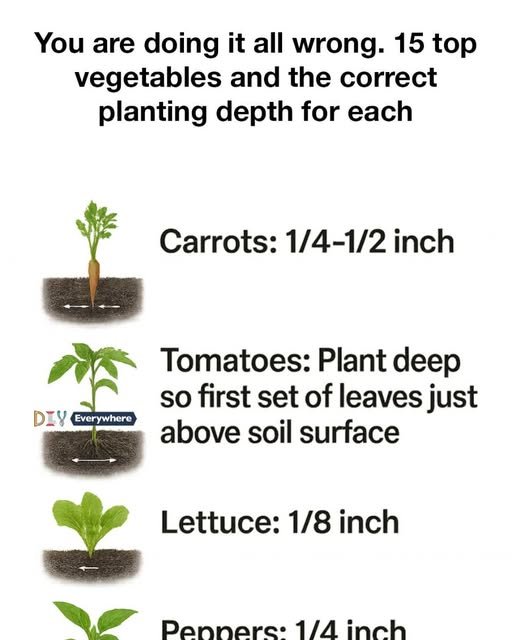Planting depth is a crucial factor in vegetable gardening that can significantly impact the growth and yield of your crops. Many gardeners overlook this aspect, leading to suboptimal growth or even failure of their plants. Understanding the correct planting depth for each type of vegetable ensures that seeds germinate properly and that plants develop strong root systems. This guide will explore the correct planting depths for 15 popular vegetables, helping you optimize your garden for a bountiful harvest.
The Importance of Planting Depth
Planting depth affects seed germination, root development, and the overall health of the plant. If seeds are planted too deep, they may not receive enough light and warmth to germinate. Conversely, if planted too shallow, they may dry out or be washed away by rain. Proper planting depth ensures that seeds have the right conditions to sprout and that plants can establish a robust root system, which is essential for nutrient uptake and stability.
1. Carrots: Achieving Optimal Growth
Carrots require a planting depth of about 1/4 to 1/2 inch. This shallow depth allows the small seeds to receive adequate warmth and moisture, which are crucial for germination. Planting too deep can hinder the seed’s ability to break through the soil, while too shallow planting can lead to drying out.
2. Tomatoes: Ensuring Strong Roots
Tomatoes benefit from being planted deeper than most vegetables. Plant them so that the first set of leaves is just above the soil surface. This depth encourages the development of additional roots along the buried stem, providing greater stability and nutrient absorption.
3. Lettuce: Shallow Planting for Success
Lettuce seeds are tiny and should be planted very shallowly, about 1/8 inch deep. They require light to germinate, so covering them with too much soil can prevent them from sprouting. A light dusting of soil or vermiculite is often sufficient.
4. Peppers: Depth for Stability
Peppers should be planted at a depth of about 1/4 inch. This depth ensures that the seeds are covered enough to retain moisture but not so deep that they struggle to reach the surface. Proper planting depth helps establish a strong root system for stability.
5. Radishes: Quick Growth with Proper Depth
Radishes are fast-growing and should be planted about 1/2 inch deep. This depth allows for quick germination and root development, leading to the rapid growth that radishes are known for.
6. Beans: Deep Roots for Nutrient Absorption
Beans should be planted about 1 to 1.5 inches deep. This depth supports the development of a strong root system, which is essential for the plant’s ability to absorb nutrients and water efficiently.
7. Cucumbers: Planting for Maximum Yield
Cucumber seeds should be planted about 1 inch deep. This depth provides enough soil coverage to retain moisture while allowing the seeds to germinate quickly. Proper planting depth is key to achieving a high yield.
8. Spinach: Shallow and Steady
Spinach seeds should be planted about 1/2 inch deep. This shallow depth ensures that the seeds receive enough light and warmth to germinate, while also allowing for steady growth.
9. Onions: Depth for Bulb Development
Onion seeds should be planted about 1/4 inch deep. This allows the bulb to develop properly just below the soil surface. Planting too deep can hinder bulb formation.
10. Peas: Supporting Tall Growth
Peas should be planted about 1 inch deep. This depth supports the development of a strong root system, which is necessary for the tall growth habit of pea plants.
11. Zucchini: Depth for Vigorous Growth
Zucchini seeds should be planted about 1 inch deep. This depth provides the seeds with enough soil coverage to retain moisture and warmth, promoting vigorous growth.
12. Beets: Ensuring Proper Root Formation
Beet seeds should be planted about 1/2 inch deep. This depth supports proper root formation and ensures that the beets develop evenly.
13. Broccoli: Depth for Strong Stalks
Broccoli seeds should be planted about 1/4 inch deep. This shallow depth allows for quick germination and the development of strong stalks.
14. Eggplant: Deep Planting for Stability
Eggplant seeds should be planted about 1/4 inch deep. This depth supports the development of a stable root system, which is crucial for the plant’s growth and fruit production.
15. Cabbage: Shallow Planting for Compact Heads
Cabbage seeds should be planted about 1/4 inch deep. This shallow planting ensures that the seeds receive enough light and warmth to germinate, leading to the development of compact heads.
Conclusion: Mastering Planting Depth for a Bountiful Harvest
Understanding and implementing the correct planting depths for your vegetables is a fundamental aspect of successful gardening. By ensuring that each type of vegetable is planted at its optimal depth, you can promote healthy growth, strong root systems, and ultimately, a bountiful harvest. With this knowledge, you can avoid common planting mistakes and enjoy the fruits (and vegetables) of your labor.



